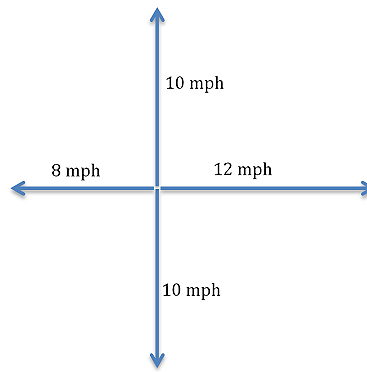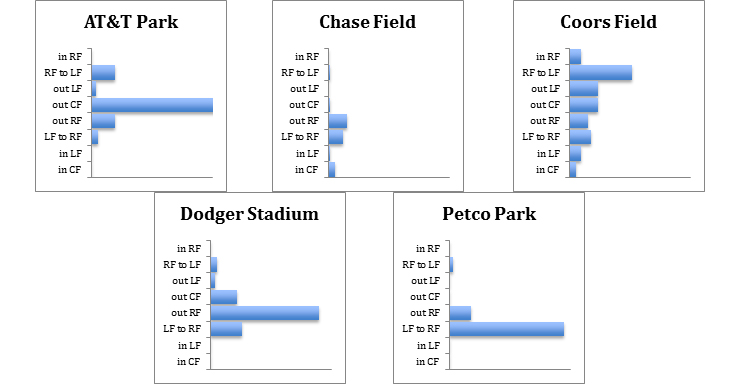© 2026 ALLCITY Network Inc.
All rights reserved.

“Friday On The Rox” is BSN Denver’s weekly highlights from baseball, and other stuff! It’s our favorite links, articles, gifs, Vines, stories, pictures, tweets, or really anything that we like that we saw in the world from the week. Of course, we’ll make it Rockies-centric.
The Hardball Times’ article a few Wednesdays ago was a great one for physics nerds like myself. Titled “The Physics of Which Way the Wind Blows,” Dr. David Kagan from CSU Chico runs down how the wind blows at each MLB park. The wind has a bigger effect than you probably think it does, and at Coors Feild where centerfield is due north from home plate, the wind often changes directions.
According to Kagan’s research Coors Field is the third least windy stadium in the National League with an average wind speed of 6.5 MPH. Only the Nationals and Dodgers have a lower average wind speed. However, the average wind velocity at Coors Field is in the middle of the pack for the National League. If you don’t know the difference between average wind speed and velocity let Dr. Kagan explain using his example below.
To find the average wind speed you just add all four speeds and divide by four. You should get 10 mph. To find the average velocity, you need to realize that the 10 mph wind up the page cancels out the 10 mph wind down the page. Meanwhile, the 12 mph wind to the right is reduced by the 8 mph wind to the left leaving a four mph wind to the right. Now divide by four.
The average wind velocity is one mph to the right, while that average wind speed is 10 mph. The average wind speed and the average wind velocity tell you different things. The average wind speed ignores direction. In baseball, direction makes all the difference. A 10-mph wind out will benefit the hitters, while a 10-mph wind in will help the pitchers.
Kagan’s data also found that most of the time wind blows out to left at Coors Field. You can see this data below.
I’ve done some research on this subject myself in ordinance to how the Rockies play in specific wind conditions at Coors Field and I found this (2010-2014):
Blowing Out: Games 141, 72-69, 6.01 RPG, 5.43 OPRG, 14.05% HR/FB
Blowing In: Games 178, 95-83, 5.96 RPG, 5.45 OPRG, 12.94% HR/FB
Neutral: Games 86, 48-38, 5.74 RPG, 4.93 OPRG, 15.66% HR/FB
Left to Right: Games 19, 17-12 6.11 RPG, 5.07 ORPG, 17% HR/FB
Right to Left: Games 57, 31-26, 5.67 RPG, 4.86 ORPG, 15% HR/FB
Not surprisingly I found that home run numbers go up when the wind blows out and go down when the wind blows in. Interestingly enough, home run numbers go up for the Rockies when the wind blows from side to side, and so does scoring when the wind blows left to right. You can most likely blame the outlier in scoring on the small sample size of 19 games over five years of data. The biggest outlier here is that HR/FB rate goes up 2.61% when the wind is blowing side to side rather than in. Perhaps the ball is being blown into gaps, or maybe the wind isn’t blowing strong enough. Just for the sake of it, I continued my research with games where winds blew more than 10 miles per hour.
Blowing out 10+ MPH: Games 16, 10-6, 6.25 RPG, 5.63 OPRG
Blowing In 10+ MPH: Games 52, 27-25, 5.73 RPG, 5.35 OPRG
Neutral 10 MPH+ Games 14, 7-7, 5.29 RPG, 4.21 ORPG
The sample size is most likely too small to make any real conclusions, but what we can learn is that scoring goes up when the wind blows out. However, the wind has a higher probability of blowing in at 20th and Blake.
There is more work to be done here, and I will get an article together which encompasses all weather sometime this offseason. Sorry for that weather pun, onto this week’s notes.
Notes:
- Nolan Arenado and Carlos Gonazlez have each won Silver Sluggers for their 2015 season
Links:
The Hardball Times / David Kagan // The Physics of Which Way the Wind Blows
Did you know, “a steady tail or head wind can change the distance of a long fly ball by three to four feet for every mile-per-hour of wind speed.”
Rockies Zingers / Nick Tremaroli // Keep Calm and Let Jeff Bridich Do His Job
Tremaroli argues, “It takes more than just one year to transform a perennially losing baseball team into a winner.”
Purple Row / Bryan Kilpatrick // Colorado Rockies farm system in great shape entering 2016
BK had a conversation with the Rockies director of player development Zach Wilson a few weeks back and if you missed it you should read it. This article has some great insight to what the Rockies are doing with their minor league system. The story has some good stuff on Antonio Senzatela, Raimel Tapia, Ryan McMahon, and way more.
Purple Row / Matt Gross // The Rockies have a very deep farm system, and could make it even deeper this winter
Gross took MLB.com’s top 100 prospects to show the high-end depth the Rockies have on the farm. Our Seth Klusmire’s “On the farm” series will continue to cover the Rockies system.
Purple Row / Cameron Goeldner // Rockies fall league updates: The AFL’s Fall Stars Game and an inside-the-park home run
Cam gives us an update on the Rockies prospects who are playing in the Arizona Fall league.
Fangraphs / Carson Cistulli // If Relegation Existed in Baseball
This is something I have long thought about and one of the best writers out there Cistulli runs down how regulation, as it exists in the EPL, would work in MLB.
Five Thirty Eight / Neil Paine, Carl Bialik // The Gold Gloves Are Finally Going To The Best Fielders
The number crunchers at 538 argue, “It was hard to tell this year’s list of Gold Glove winners, announced Tuesday night, from a list of players with the best advanced defensive metrics. That’s no coincidence.”
Baseball Prospectus / Brendan Gawlowski // Soft Toss: An Ode to LaTroy
I had the pleasure of interviewing LaTroy Hawkins during the season, Gawlowski writes, “Surviving in the major leagues for two decades requires more than a strong arm and a clean bill of health. It’s not easy to conjure enough internal motivation to improve at the craft every day, to keep the body in shape, to stay strong mentally in the face of long seasons and bad outings. You can’t get through all of the bus rides, injuries, blown saves, midnight phone calls, and nights away from home without a mean competitive streak.”
MiLB.com / Sam Dykstra // Toolshed: Final Triple-A park factors review
This is pretty interesting to look at if you like minor league baseball. Especially if you watch the minors and take the stats with a grain of salt.
Twitter’s Top Five:
Little Leaguer Haunted By 386 Errors He Made Last Season pic.twitter.com/2omKc2sUwz
— Onion Sports Network (@OnionSports) November 12, 2015
"How many types of gondolas should we have?"
"For text messages?"
"Yes. For text messages."
"At least three. Three gondola types."#🚡🚠🚟
— Jesse Thorn 🤷♂️ (he/him) (@JesseThorn) November 12, 2015
Interesting offensive strategy by the Hurricanes here pic.twitter.com/BY5lXVWqfv
— Gregory Balloch (@GregBalloch) November 11, 2015
CarGo and a Fan pic.twitter.com/Nbv5TJ6QDg
— Jake Shapiro, but festive 🎁 (@Shapalicious) November 12, 2015
Tweet of the week:
why would any player accept a koalafying offer? pic.twitter.com/SWVsT6LEyC
— Productive Outs (@ProductiveOuts) November 8, 2015
Music for the weekend: Chet Faker’s new song is one you will be hearing often on the radio. Get out in front of it and listen to it now, he is awesome, this song is sick, and he is one of my favorites. He was on the Song Exploder podcast recently where he explained how he made his hit single “Gold.” Have a great weekend, make it fun!
Comments
Share your thoughts
Join the conversation






